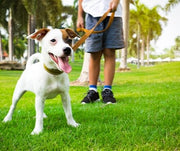How to Know If Your Dog is Playing Too Rough

Q: How do I know if my dog’s play behavior is becoming too rough? I always thought it was just his excitement, but for the safety of other dogs and my family, I would feel more comfortable knowing his limits. How can I help to not support his rough behavior?
A: If you are concerned with how rough your dog plays, familiarize yourself with their limits to be proactive, and by training them when to calm down as they become overly excited. Their body language will say a lot about how they are feeling in a situation. Usually, during playtime, their body will be limp, and their mouth will hang open as their tongue droops to the floor. This is a sign of a happy dog who is enjoying some friendly play. Watch for a sudden shift in mood, where their body becomes stiff and tail is held high (showing confidence or dominance). As their “happy mouth” closes, they debate if the situation calls for them to run or fight. In this moment, immediately stop playtime and create a distraction with a toy. If, the situation presents itself when your dog is playing with another dog, calmly call him to you. You’ll notice his threshold of when he crosses the line, typically the transition occurs when excitement happens too quickly.
If your pup likes to yank on your clothes or hands or just flat out bites during playtime, redirect and teach him to grab a specific toy instead, like a JW Giggle Tug. The wide loops will create distance between you and your dog, while the “giggle” noise distracts them from nibbling. Yanking and biting are not necessarily aggressive since dogs play by biting one another, the difference is dogs have the senses to know when they need to stop. Humans are limited on how we can prevail to dogs when the biting or playtime becomes too aggressive, so finding a diversion is ideal.
We all love to wrestle or play tug-o-war with our dogs, especially with our bigger pooches. Our dogs will agree that rolling around is fun and exciting, but when is rough play too much? This kind of behavior mimics how dogs interact together and is used to establish dominance among other dogs. While it is fine to partake in a wrestle session, keep a watch on when a dog’s mood does change.
For those who do enjoy the occasional wrestle battle on the living room floor, there are few guidelines you can follow to ensure it is all fun and games. You should always be the one to initiate the fun, never your dog, and your dog should know your signal when to stop. With puppies, you can train them with a code word like “settle” or “the end” so he learns to calm down after rough play. Like mentioned before, if your dog begins to nibble on you, immediately stop playing, and transition the dog’s focus to another object. When wrestling becomes too much, switch over to a game of tug with the Chuckit! Ultra Duo Tug. This is an ideal toy that combines fetch and tug all in one!
Don’t hesitate to roll around with your dog. After a few times, you’ll be able to tell if your dog enjoys wrestling by whether they come back for more. Reserved pups usually will not enjoy this form of playtime. In that instance, you should consider another game to play with them. The decision should be made by favoring what is right for your dog. If you know their limitations, you can get a better understanding of when to stop the wrestling or avoid it all together. Have fun with your pup in the safest way you know how!
Sources:
Previous article

Next article

Related posts
View all-

What Can You Use Instead of Cat Litter?
Traditional cat litter is convenient, but it’s not the only option. Many cat owners look for alternatives to reduce waste, save money, or avoid chemicals found in clay-based kitty litter. Some options offer better odor control, while others are more eco-friendly or gentler on a cat’s paws.
Read Article -

How to Keep My Backyard Smelling Fresh
A clean backyard should smell fresh, unlike pet waste, smoke, or mold. Bad smells can linger, especially when dog poop, urine, or food scraps attract flies and bacteria. If your yard has a foul odor, it's time to take action. The first step is cleaning up pet feces, trash, or rotting food. A garden hose can wash away dirt and urine from artificial turf, patios, and decks. To neutralize odor, Use baking soda, white vinegar, and essential oils.
Read Article -

What Supplies Do First-Time Cat Owners Need?
Bringing home a new cat is exciting, but making them feel safe and comfortable takes more than love. First-time cat owners must prepare with the right supplies to ensure a smooth transition. From a litter box to cat food and a warm bed, having the basics ready can help your new kitty settle in faster. This guide covers everything a new cat owner needs to make their new pet feel at home.
Read Article



